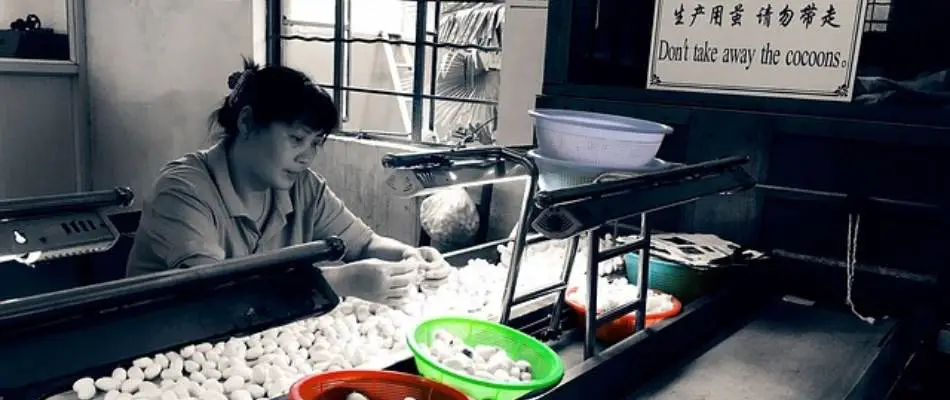Silk Reeling is an extremely misunderstood and mystified set of movements. On one hand, they are indeed a fairly simple and repetitive part of tai chi practice. For this, they suffer a reputation of being basic or unimportant.
On the other hand, every master describes the necessity and benefits of doing silk reeling exercises. To that point, I can’t think of a single class, workshop, or private lesson that hasn’t at least began or ended with silk reeling.
The truth is, tai chi practitioners who incorporate silk reeling into their training benefit immensely. Not only that, but silk reeling exercises serve as a kind of invisible instructor which can help you improve your movements, wake you up to internal energy, and provide you with needed feedback as to what you need to correct and focus on. All we need to do is understand a bit about the history of silk reeling, know why we would do it, and how to correctly use it to improve our tai chi practice.
Read down to get an understanding of what silk reeling is and then we show you some videos and a download so that you can add it to your practice.
Pro-tip: Silk reeling is a “foreign” topic for most of us and is best absorbed through additional learning. Luckily there are about a half dozen books that have been written and translated on the topic.
What is Silk Reeling?
Silk reeling (Chan Si Gong in Chinese) is a series of exercises used to cultivate “Chan Si Jin” or Silk Reeling Energy which is present the spiraling movement is tai chi when it is practiced correctly. The majority of the silk reeling exercises are found within the various tai chi forms. In silk reeling however, you typically stand in one place and practice the move in isolation for several repetitions.
What’s in a Name?
Its name is derived from the way silk is gathered from the silkworms. Constant deliberate tension is used to draw the silk thread out. If you pull to hard it breaks. Pull to softly and you get nothing or the strands get tangled. This name is important because is intended to convey the intent you hold in your mind with every movement and the sensation that you are going for. Each movement is long and continual with slight tension. So….think of every movement as possessing both hard and soft energy in every movement.

What is the History of Silk Reeling Exercises?
The short history of silk reeling is the cornerstone of the argument for those among us that think it is unimportant. Silk reeling was not traditionally practiced and only grew in use in the 19th Century. Here is why the nay-sayers among us should reconsider their stance: Prior to the 1900s, correct power, energy, and movement were obtained by a tremendous amount of practice. Grand Master Chen Fake (fah-kuh) was reported to do the long form 10 times each day. With an increase in demands on the individuals in a modernizing China, Silk Reeling Exercises were introduced to still produce the desired outcome in practitioners.
19th generation master Chen Zhaopi explained that silk reeling was deemed necessary for learners to grasp the spiraling and rotational movement and build internal strength so that “all movements are circular, with no sharp angles or flat surfaces, no deficiencies or excesses.”
We are better off thinking of silk reeling as an update or modernization for our progress that was developed by the same Grand Masters who taught the form. It is necessary for progress – unless you practice 10 times each day! More power to you.
How are Silk Reeling Exercises Different from Just Doing Tai Chi?
Grand Master Chen Zhaopi shared that when Tai Chi Chuan is performed correctly, each movement contains Chan Si Jin (Silk Reeling Energy). This is to say that each movement contains spiraling energy with no straight lines or angles. You can see how tough this can be to maintain this energy and concentration across the 75-108 movements of the long form. Silk reeling gives us the chance to practice creating this energy in repetitive movements until they are engrained as habit and inserted back into the form.
So: Tai Chi is Silk Reeling when practiced correctly. Tai chi practice devoid of spiraling movements, isn’t tai chi. Ouch! I know. I remember early on at a workshop when I was asked to demonstrate part of the form and was told: “That wasn’t tai chi.” I was really confused and insulted! I later learned that this was the point that they were trying to make: my movements didn’t contain Chan Si Energy. If this idea is new to you, we wrote an article on tai chi energy.
How to Effectively Use Silk Reeling to Improve Your Tai Chi Practice
Okay, glad you read down this far because I want to share how you can easily and effectively use silk reeling to have your form and energy dramatically improve without even having a teacher present. The only other way to gain correct movement and power this quickly is by doing the form a ton or learning a tai chi ball set. Regardless, silk reeling energy will be in both.
Thee are 3 ways to Improve Your Tai Chi Practice:
1: The Full Set
If you have the benefit of living in an area with a lot of martial arts maybe you could find a class with tai chi practice that teaches the entire sequence of movements. I learned a set that goes from head to toe and takes about 90 minutes. This is nice to do from time-to-time but is really overkill, especially if you are battling just to find time to do the form.
2. Examples of Silk Reeling on YouTube and Resources
Most of the exercises can be found on the Internet. There are people presenting one to 20 movements and even selling courses on them. Not bad if you know what to do with them (next part). Here are some examples of silk reeling performed by a California-based teacher as well as notes taken from workshops from a school in Texas.
Forward/Backward Double Silk Reeling
Forward/Backward Double Big Silk Reeling
3. Repeat Movements from the Form
I have to repeat Chen Zaopai so that you see the double meaning in his words:
Tai Chi Chuan is Silk Reeling when movements contain spiraling energy
This is the simplest (best?) way and this is what it looks like: You start your form and totally rock the first 4 movements. You are smiling relaxed and grounded. You then transition into the next move, are not too sure about it, but skip past it to get to move 6 which feels better. Stop, and repeat move 5 as an isolated exercise 9 times, judging yourself with the following criteria.
10 Steps to Perfect a Tai Chi Move Using Silk Reeling
- Keep the body upright and the spine naturally straight
- Relax the chest and let it sink
- Suspend the top of the head from a thread
- Place your tongue against the palate breathing through the nose
- Relax the shoulders down
- Sink the elbow but keep space in the armpits
- Shift weight moving from the dan tien or lower
- If the arms and legs are moving, make sure the moves are circular
- For the hand movements, the hands should never cross the sternum line, rotate your torso instead. For most movements, the hand never goes higher than the eyebrow or below the groin.
- Keep the mind calm and place your intention on slow heavy sweeping movements. If your internal energy is developed, you will feel a heaviness on your arms and hands as they travel.
Then just stick the move back into the form and look for improvement.
Silk reeling exercises make complete sense if you rinse the esoteric mud off of them and see them as being the same way we learn anything in life. If you wanted to play the guitar, you would practice the placement, strumming, speed, notes and anything else separately before you glued it together to play a “song.” Silk reeling allows us to take the different aspects of the form apart to practice them before putting them back together to get good tai chi. In an interview that we did with longtime practitioners, all of the their focuses eventually circled back to moving correctly which is embodied in the silk reeling exercises.



